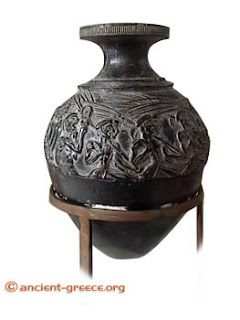Minoan Bull and Acrobat
http://www.britishmuseum.org/explore/highlights/highlight_objects/gr/b/minoan_bull_and_acrobat.aspx
This is a sculpture of a man catapulting himself onto a bull by the horns, it is very likely that the missing limbs are a result of failed casting. Minoan Bronze was very low in tin and thus had limited flow.
Pottery Jar with Exaggerated Spout
http://www.britishmuseum.org/explore/highlights/highlight_objects/gr/p/pottery_jar,_exaggerated_spout.aspx
Vassiliki vases of this kind are referred to as "tea pots", because of their unusual shape. This vase appears to be emulating metallic vases, with its false rivets and burnished appearance.
http://www.jstor.org/discover/10.2307/507232?uid=3739840&uid=2&uid=4&uid=3739256&sid=21102594859101
The infamous Phaistos disk was discovered in the main cell of a temple depository. It has proven to be infernally difficult to crack, stumping amateur and professional archaeologists alike.
http://employees.oneonta.edu/farberas/arth/ARTH200/Body/snake_goddess.htm
A faience aspect of the Minoan Snake Goddess, little is known about her because Minoan Linear A has yet to be deciphered.
http://www.ancientgreece.com/MinoanArt/
A Fresco of Minoan Women in typical high class dress.
http://www.metmuseum.org/toah/works-of-art/1973.35
This adorable Rhyton was used for libation (sacrificial liquid pouring). It would be immersed in the selected liquid (blood or wine, likely) and poured for a rite of some kind.
The Larnax
http://www.metmuseum.org/toah/works-of-art/1996.521a,b
This terra cotta chest was a standard burial place. The interred was contorted into the fetal position, placed inside, and then the Larnax was lowered into the resting place.
http://www.metmuseum.org/toah/works-of-art/1999.423
A pyxis of unknown purpose, but it can be inferred that it had some spiritual purpose because it has some patterns in common with the Larnax.
Harvest Rhyton
http://www.ancient-greece.org/art/minoan-art.html
A depiction of workers either entering or leaving an olive plantation, very expressive figures make this work a bit of an anomaly.
Cypriot
http://www.metmuseum.org/toah/works-of-art/74.51.5684
A glorious tripod with signs of ancient repairs, indicating that it was a treasured item, not easily replaceable.










No comments:
Post a Comment